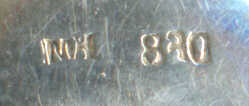
The "830" is for silver content.
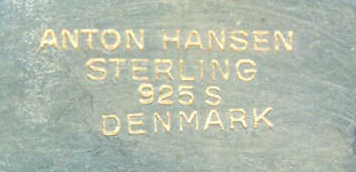
The "STERLING" and "925S" are for silver content.
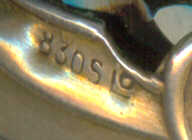
The "830S" is for silver content.
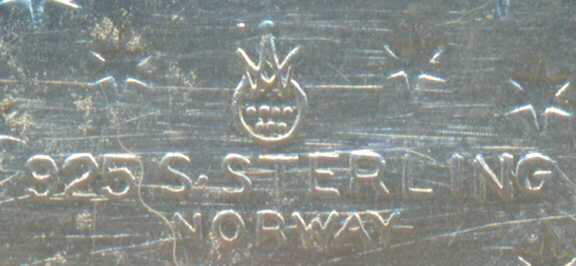
The "925 S·STERLING" is for silver content.
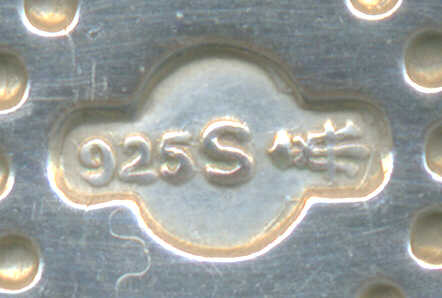
The "925S" is for silver content.
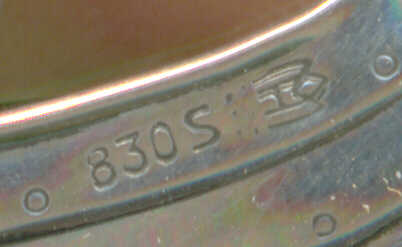
The "830S" is for silver content.
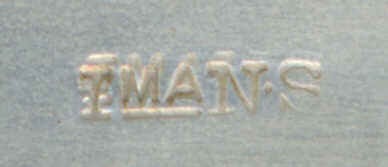




|
|
 |
The "MH" mark is for Marius Hammer of Bergen, Norway. 1847 to 1927. There is also a Marius Hammer marking of an inverted hammer superimposed on an uppercase "M". The "830" is for silver content. |  |
The "ANTON HANSEN" mark is for Carl Anton Koch Hansen of Copenhagen, Denmark. 1952 to 1980. May also be marked as "Ant.H." The "STERLING" and "925S" are for silver content. |
 |
What is often identified as "LO" is the mark for Brødrene Lohne of Bergen, Norway. Date usage unknown. The "830S" is for silver content. |
 |
The crown-shaped mark is for Theodor Olsens Eftf, of Bergen, Norway. Date usage unknown (possibly 1965?). There are a few variations of this mark. The seven dots in the circle represent the seven hills that surround the city of Bergen - they are also found on the old Bergen city silver mark, itself taken from the municipal arms. The "925 S·STERLING" is for silver content. |
 |
The hammer and tongs mark is for David Andersen of Christiania (now Oslo, as of 1906), Norway. There are several different makers marks associated with the David-Andersen company; this mark is dated as in use from circa 1888 to 1925 (another source dates this mark from 1924 to 1939). See this page for more information on the David-Andersen company, and other mark examples. The "925S" is for silver content. |
 |
The mark on the right (it's sideways) is an "M" superimposed with an "A", with seven dots below, and is the mark for Magnus Aase of Bergen, Norway. 1876 to 1953. Although his mark sometimes has a dot or circle above it, this one does not (what looks like a circle above the mark is only one of the rivets detailed on the ship's planks). This mark has the same seven dots that Theodor Olsens Eftf's mark has (see above). There seems to be some connection between Magnus Aase and Theodor Olsens Eftf, but I am still working on that part. The "830S" is for silver content. |
 |
This mark was found on a ship that appears to be silver-plated. Although not absolutely certain, the best guess is that the 'N·S' means alpaca or nickle silver, and the 'IMA' has a connection to a Swedish term 'Prima', indicating silver plating of at least 20 grams (meaning this ship is silverplate over a base metal of alpaca). Anyone with more information about this mark is welcome to contact me. |  |
This mark consists of an oval that incorporates 4 dots on the left curve, and 3 dots on the right curve, for a total of 7 dots. 7 dots is a design element of a few other Norwegian marks (see above). Inside the oval is an upwards-pointing arrow. I believe, but have not yet confirmed, that this mark is of Kristian M. Hestenes, of Bergen, Norway. |  |
This ship has four markings. From left to right, they are: the Danish two-tower mark that stands for silverplate (solid silver is indicated by three towers). Next is the word "ENERET", which means 'patent' or 'monopoly', and indicates exclusive use of a design. Next is a mark which so far I have been unable to identify. And finally, in an oval, the word "ASTRAL" with two wavy lines below it, also so far unidentified. |  |
The "830S" on this ship is for silver content. I have not yet indentified the "WP." mark. |  |
This mark is on a pewter ship (pewter, no shields, ship number 1). One source attributes this mark to Arne Haugrud of Tønsberg, Norway. Another source attributes it to a company called Andresen and Holmsen, of Sandefjord, Norway, which is no longer in business. |